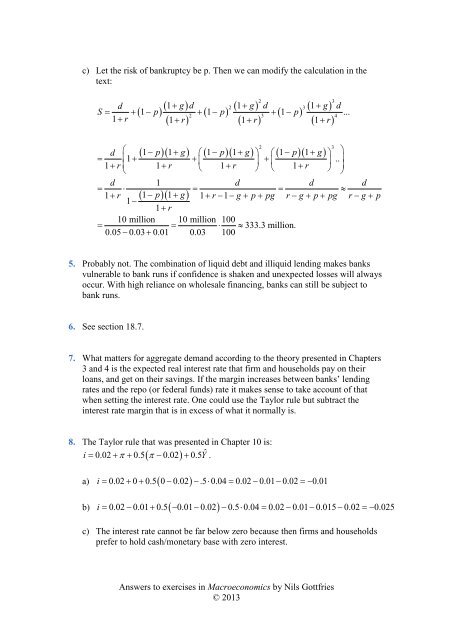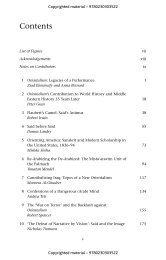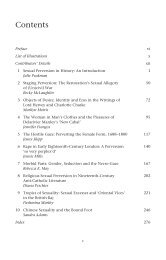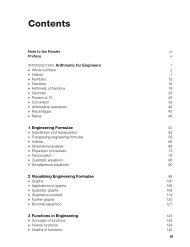Answers to exercises in Macroeconomics by Nils Gottfries ... - Palgrave
Answers to exercises in Macroeconomics by Nils Gottfries ... - Palgrave
Answers to exercises in Macroeconomics by Nils Gottfries ... - Palgrave
Create successful ePaper yourself
Turn your PDF publications into a flip-book with our unique Google optimized e-Paper software.
c) Let the risk of bankruptcy be p. Then we can modify the calculation <strong>in</strong> the<br />
text:<br />
( ) ( )<br />
( )<br />
2 3<br />
2 3<br />
2 3 4<br />
d 1+ g d 1+ g d 1+<br />
g d<br />
S = + 1− p + 1− p + 1 − p ...<br />
1+ r 1+ r 1+ r 1+<br />
r<br />
( ) ( )<br />
( )<br />
( ) ( )<br />
( )<br />
( 1− p)( 1+ g) ( 1− p)( 1+ g) ( 1− p)( 1+<br />
g)<br />
2 3<br />
d ⎛<br />
⎛ ⎞ ⎛ ⎞ ⎞<br />
= 1 + + ⎜ ⎟ + ⎜ ⎟ ..<br />
1+ r⎜<br />
1+ r 1+ r 1+<br />
r ⎟<br />
⎝<br />
⎝ ⎠ ⎝ ⎠ ⎠<br />
d 1<br />
d d d<br />
= ⋅ = = ≈<br />
1+ r ( 1− p)( 1+<br />
g)<br />
1+ r−1− g+ p+ pg r− g+ p+ pg r− g+<br />
p<br />
1−<br />
1+<br />
r<br />
10 million 10 million 100<br />
= = ⋅ ≈ 333.3 million.<br />
0.05 − 0.03 + 0.01 0.03 100<br />
5. Probably not. The comb<strong>in</strong>ation of liquid debt and illiquid lend<strong>in</strong>g makes banks<br />
vulnerable <strong>to</strong> bank runs if confidence is shaken and unexpected losses will always<br />
occur. With high reliance on wholesale f<strong>in</strong>anc<strong>in</strong>g, banks can still be subject <strong>to</strong><br />
bank runs.<br />
6. See section 18.7.<br />
7. What matters for aggregate demand accord<strong>in</strong>g <strong>to</strong> the theory presented <strong>in</strong> Chapters<br />
3 and 4 is the expected real <strong>in</strong>terest rate that firm and households pay on their<br />
loans, and get on their sav<strong>in</strong>gs. If the marg<strong>in</strong> <strong>in</strong>creases between banks’ lend<strong>in</strong>g<br />
rates and the repo (or federal funds) rate it makes sense <strong>to</strong> take account of that<br />
when sett<strong>in</strong>g the <strong>in</strong>terest rate. One could use the Taylor rule but subtract the<br />
<strong>in</strong>terest rate marg<strong>in</strong> that is <strong>in</strong> excess of what it normally is.<br />
8. The Taylor rule that was presented <strong>in</strong> Chapter 10 is:<br />
i = 0.02 + π + 0.5 π − 0.02 + 0.5Y<br />
.<br />
( ) ˆ<br />
a) i = 0.02 + 0 + 0.5( 0 −0.02 ) −.5⋅ 0.04 = 0.02 −0.01− 0.02 = − 0.01<br />
b) i = 0.02 − 0.01+ 0.5( −0.01−0.02)<br />
−0.5⋅ 0.04 = 0.02 −0.01−0.015 − 0.02 =−0.025<br />
c) The <strong>in</strong>terest rate cannot be far below zero because then firms and households<br />
prefer <strong>to</strong> hold cash/monetary base with zero <strong>in</strong>terest.<br />
<strong>Answers</strong> <strong>to</strong> <strong>exercises</strong> <strong>in</strong> <strong>Macroeconomics</strong> <strong>by</strong> <strong>Nils</strong> <strong>Gottfries</strong><br />
© 2013
















